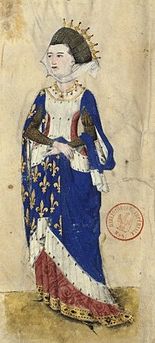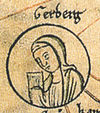
Louis the Pious, also called the Fair and the Debonaire, was King of the Franks and co-emperor with his father, Charlemagne, from 813. He was also King of Aquitaine from 781. As the only surviving son of Charlemagne and Hildegard, he became the sole ruler of the Franks after his father's death in 814, a position that he held until his death except from November 833 to March 834, when he was deposed.
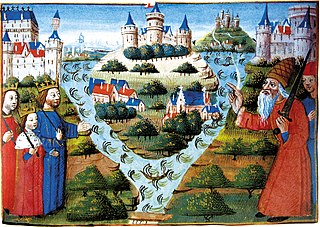
The Treaty of Verdun, agreed in 10 August 843, divided the Frankish Empire into three kingdoms between Lothair I, Louis II and Charles II, the surviving sons of the emperor Louis I, the son and successor of Charlemagne. The treaty was concluded following almost three years of civil war and was the culmination of negotiations lasting more than a year. It was the first in a series of partitions contributing to the dissolution of the empire created by Charlemagne and has been seen as foreshadowing the formation of many of the modern countries of western Europe.
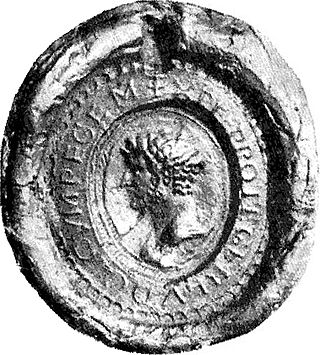
Louis the German, also known as Louis II of Germany, was the first king of East Francia, and ruled from 843 to 876 AD. Grandson of emperor Charlemagne and the third son of Louis the Pious, emperor of Francia, and his first wife, Ermengarde of Hesbaye, he received the appellation Germanicus shortly after his death, when East Francia became known as the kingdom of Germany.

Charles the Bald, also known as Charles II, was a 9th-century king of West Francia (843–877), King of Italy (875–877) and emperor of the Carolingian Empire (875–877). After a series of civil wars during the reign of his father, Louis the Pious, Charles succeeded, by the Treaty of Verdun (843), in acquiring the western third of the empire. He was a grandson of Charlemagne and the youngest son of Louis the Pious by his second wife, Judith.

Neustria was the western part of the Kingdom of the Franks during the Early Middle Ages, in contrast to the eastern Frankish kingdom, Austrasia. It initially included land between the Loire and the Silva Carbonaria, in the north of present-day France, with Paris, Orléans, Tours, Soissons as its main cities.

Lothair I was a 9th-century Carolingian emperor and king of Italy (818–855) and Middle Francia (843–855).

Lotharingia was a medieval successor kingdom of the Carolingian Empire. It comprised present-day Lorraine (France), Luxembourg, Saarland (Germany), Netherlands, most of Belgium, and Germany west of the Rhine. It was named after King Lothair II, who received this territory as his share of the Kingdom of Middle Francia which his father, Lothair I, had held.

The Kingdom of the Franks, also known as the Frankish Kingdom, the Frankish Empire or Francia, was the largest post-Roman barbarian kingdom in Western Europe. It was ruled by the Frankish Merovingian and Carolingian dynasties during the Early Middle Ages. Francia was among the last surviving Germanic kingdoms from the Migration Period era.

The Treaty of Mersen or Meerssen, concluded on 8 August 870, was a treaty to partition the realm of Lothair II, known as Lotharingia, by his uncles Louis the German of East Francia and Charles the Bald of West Francia, the two surviving sons of Emperor Louis I the Pious. The treaty followed an earlier treaty of Prüm which had split Middle Francia between Lothair I's sons after his death in 855.

The Duchy of Aquitaine was a historical fiefdom located in the western, central and southern areas of present-day France, south of the river Loire. Although the full extent of the duchy, as well as its name, fluctuated greatly over the centuries and at times comprised much of what is now southwestern (Gascony) and central France.

Lothair, sometimes called Lothair II, III or IV, was the penultimate Carolingian king of West Francia, reigning from 10 September 954 until his death in 986.

East Francia or the Kingdom of the East Franks was a successor state of Charlemagne's empire ruled by the Carolingian dynasty until 911. It was created through the Treaty of Verdun (843) which divided the former empire into three kingdoms.
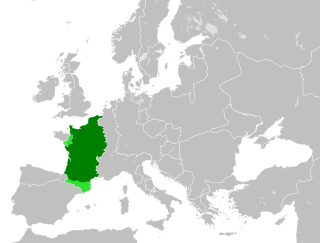
In medieval historiography, West Francia or the Kingdom of the West Franks constitutes the initial stage of the Kingdom of France and extends from the year 843, from the Treaty of Verdun, to 987, the beginning of the Capetian dynasty. It was created from the division of the Carolingian Empire following the death of Louis the Pious, with its neighbor East Francia eventually evolving into the Kingdom of Germany.

Middle Francia was a short-lived Frankish kingdom which was created in 843 by the Treaty of Verdun after an intermittent civil war between the grandsons of Charlemagne resulted in division of the united empire. Middle Francia was allocated to emperor Lothair I, the eldest son and successor of emperor Louis the Pious. His realm contained the imperial cities of Aachen and Pavia, but lacked any geographic or cultural cohesion, which prevented it from surviving and forming a nucleus of a larger state, as was the case with West Francia and East Francia.

The Treaty of Prüm, concluded on 19 September 855, was the second of the partition treaties of the Carolingian Empire. As Emperor Lothair I was approaching death, he divided his realm of Middle Francia among his three sons.

Louis IV, called d'Outremer or Transmarinus, reigned as King of West Francia from 936 to 954. A member of the Carolingian dynasty, he was the only son of king Charles the Simple and his second wife Eadgifu of Wessex, daughter of King Edward the Elder of Wessex. His reign is mostly known thanks to the Annals of Flodoard and the later Historiae of Richerus.

The Franco-German war of 978–980 was fought over possession of Lotharingia and over personal honour. In the summer of 978, King Lothair of West Francia (France) launched a surprise attack on Aachen, almost capturing the Emperor Otto II, king of East Francia (Germany) and of Italy. By autumn Lothair had returned to West Francia, while Otto had convoked a diet and assembled an army. To avenge his honour, Otto invaded West Francia. Unable to take Paris after a brief siege, he returned to Lotharingia. During his retreat, after the bulk of his army had crossed the river Aisne, the West Franks caught up to his baggage train and slaughtered it. In 980, the kings made peace. Lothair renounced his claim to Lotharingia.
